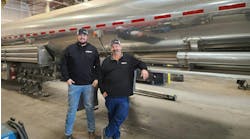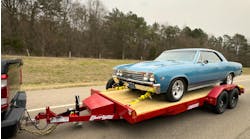Why do trailers fail? And, more importantly, what can trailer manufacturers do to protect themselves—to reduce accidents and limit their exposure to calls from plaintiffs’ attorneys looking for a payday? The issue was the subject of a pair of presentations from experts in trailer design and accident reconstruction at this year’s NATM convention.
“Most times, trailers don’t fail,” Steve Tuskan said, opening the discussion in front a packed conference meeting room. “There’s an allegation of failure for the accident and it’s up to the forensic guys working with you as manufacturers to figure out exactly what happened. But it generally is an allegation. It’s not a failure.”
Tuskan and co-presenter Mark Leonard each have more 30 years’ experience in the trailer industry, and it’s not a stretch to say that they’ve help write the book on trailer standards (NATM’s Guidelines) and testing.
Tuskan specializes in the investigation, analysis, and reconstruction of vehicular incidents. Leonard’s professional practice is focused in the areas of accident investigation and reconstruction, trailer design, and testing.
They represent Rimkus Consulting Group, which specializes in forensic engineering and consulting around the world. As part of the practice, the maintains a full-service test facility capable of conducting the full range of tests necessary for proper product evaluation, Tuskan noted.
“We cut our teeth in trailer dynamics, trailer testing and hitch testing,” he said.
And, as would be expected from engineers accustomed to making precise arguments, they packed a lot of information into their respective 45-minute sprints through their point-by-point outlines: Tuskan offering an analysis of trailer accidents; Leonard an explanation of the science behind “the tribal knowledge” built and shared over decades of trailer design and testing.
“This is Mark’s and my 30-plus years each in the industry saying these are the failures that we deal with most,” Tuskan said. “But when you think of the tens of millions of trailers on the road, there are not a lot of trailer accidents. And that’s a credit to you in this room, it really is. And it’s a credit to NATM, for putting together the guidelines and providing you the information.”
Those most common accident allegations involve trailer separation; trailer braking; wheel separations; warnings and instructions; towing ratios; and trailer sway/stability. In digging deeper into each, Tuskan identified the most common causes for each type, and many simply are not the fault of the manufacturer. But the problems must be recognized to be mitigated—and defended against in court.
Trailer separations, for instance, get complicated because there are so many methods (ball and socket, king pin, gooseneck, ring and pintle) simply to connect the trailer to the tow vehicle—and each has its own ways to fail, with many of those caused by user error or carelessness. The audience quickly came up with a half-dozen different possible reasons for separations.
For trailer builders, this is where the SAE J684 (Trailer Couplings, Hitches, and Safety Chains) and SAE J2638 (Fifth Wheel and Gooseneck Attachment Performance) standards come in.
“There is no authoritative punishment if you don’t follow [the standard],” Tuskan said. “But if you don’t follow it, the first time you get sued they’re going to bring in the Federal Motor Vehicle Safety Standards, the FMCSRs, and right behind that is going to be the SAE document. It’s a self-policing compliance.”
Of course, the coupler manufacturers do the standards testing for their product. Trailer builders need to focus on the attachment of the coupler to the tongue. And this isn’t a place to experiment with something new and unique.
“When a coupler manufacturer provides instructions about how to attach their coupler, whether it’s welding or bolt on, follow those instructions to the ‘T’,” Tuskan said. “If you’re doing any kind of welding, make sure it’s by a certified welder that knows what they’re doing. We’ve all seen couplers get torn off, couplers unbolted. That happens, and it falls right back on the manufacturer.”
Likewise, safety chains shouldn’t be an afterthought. They’re “the last line of defense” after a trailer separation.
Essentially, the chain grade, hooks, and placement all must be evaluated and deemed appropriate for the application—and for the end user.
“Know your market,” he said.
Brakes and wheels
Tuskan’s presentation then similarly analyzed standards regarding trailer braking and stability (SAE J2664, SAE J2807) and the various brake types.
“The biggest issue that we have with electric brakes is ensuring the battery is charged,” he said. “I can’t tell you how many times I go out and inspect an electric brake trailer that’s been involved in an accident, and there is no battery or the battery is completely dead. And that’s a maintenance issue, but it gets back to you folks, as trailer manufacturers, again, as a customer awareness issue.”
Poor wiring also is a common source of problems.
“If you’re running electric brake wires, be cognizant of where you’re running them and get them tied down so they’re protected either in the frame rail or within the tube,” he said. “It doesn’t do any good if the wires aren’t connected to the electric brakes.”
As for preventing wheel separations, Tuskan emphasized proper wheel selection by the trailer manufacturer—and, again, the need to follow the supplier’s directions.
“If the customer wants some fancy nuts, but the wheel instructions say you need to use a one-piece flange nut on this wheel—that’s what you use,” he said. “If it doesn’t talk about lubrication, don’t use lubrication.”
Warning and instructions
For additional protection, Tuskan recommends trailer manufacturers include the supplier’s product information in their trailer owner’s manuals.
“If the end user has a problem with the coupler and they need to find a new handle for a latch, they have a direct contact to the manufacturer of that coupler,” he said. “That gives you the ability to say later on that it was included in the purchase documentation.”
Indeed, both Tuskan and Leonard are proponents of comprehensive buyer’s packets and manuals, along with labeling on the trailer. Getting back to trailer separation issue, trailers should have a decal with instructions on how to properly connect to the tow vehicle, Tuskan suggested.
“We’re dealing with consumers who sometimes need a little bit of help,” he added.
Even something as simple as a 1-800 number on the trailer will benefit both the consumer and the manufacturer.
“When I testify in court and there’s an accident, somebody always says, ‘Well, you know, I couldn’t find where to buy the parts for the hitch or the coupler latch,’” Tuskan recalled. “It’s great for me to be able to say, ‘look, there’s the decal; they could have contacted the trailer manufacturer to find the right parts.’”
Similarly, decals can be an aid to trailer maintenance and repair. Tuskan cites the need for battery maintenance instructions to ensure electric brakes function properly, and the usefulness of labels on the top of a wheel indicating the proper torque—particularly useful for dealer prep when trailers are shipped without wheels and tires.
Generally, such decals should be placed in an area where they’ll be noticed and needed. The appropriate standard to follow is ANSI Z535 and referenced in Guidelines.
Leonard suggested a QR code would be ideal for providing instructions, such as how to hook up the trailer.
“Everybody’s got a cell phone now,” Leonard said. “The QR code pulls up video, and takes less space than a decal.”
But don’t overdo it.
“You don’t want the trailer looking like Barnum and Bailey, with so many decals on everything that nobody’s paying attention to anything,” Tuskan said.
The end user also should have access to basic trailer loading principles and towing techniques.
“A lot of accidents we deal with have to do with the driver saying, ‘once I was on the road and I didn’t know this, or I didn’t know that’,” Tuscan said.
And while most SUVs and pickup manufacturers include towing information in their owner’s manual, it’s “equally important” for trailer builders—and for their own protection, Tuskan suggested. He encouraged the audience to take advantage of the NATM brochure, “Safely Towing a Trailer,” which provides general guidance, tips, and important factors to consider.
In case of accident
Tuscan concluded his presentation offering trailer manufacturers some basic guidance on how to respond to accident reports and lawsuits.
“So why reconstruct an accident? It’s important to you as manufacturers to get as much information as you can,” he said. “Information is power; knowledge is power.”
But the unknown leads to trouble for trailer manufacturers in court. As an example, Tuscan describes a case where a trailer is involved in an accident, then shuttled off to wrecker yards where it could sit for two years, and maybe even gets scrapped. Then the consumer can claim any number of problems that can’t be disproved without the trailer.
Among the information to gather in preparing to defend against a claim, Tuscan suggested areas of focus:
human data, such as statements for people involved in the accident and witnesses; police and fire reports; driver records; owner photos of the equipment; media reports; cell phone and GPS data; even social media activity
environmental data, such as weather and road conditions, roadway maintenance, traffic, etc.
vehicle data, specifically the weight of both the tow vehicle and trailer; crash data from the vehicles data recorder, which will show speed, braking, steering inputs and more; dashcam footage; possibly nearby surveillance camera footage; and
trailer data, including manufacturer documentation, as specified in Guidelines, such a design drawings, testing results, etc.
Tuskan emphasized the importance of having a formal document retention policy.
“Go through your files; there’s no reason to save documents on a trailer you built 15 years ago. Save the important documents, the design information, engineering change orders,” he said. “When you’re served that letter that says we want all the documents on Steve’s XYZ trailer, your lawyer will write back that you have a document retention policy, that you only save documents seven years and you’ll provide the documents you have.”
(Editor’s Note: Due to magazine page limitations, Mark Leonard’s overview of trailer dynamics will be presented in an upcoming issue.)










